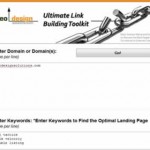The first and most powerful source for SEO and rankings is your own website.
A website deploying topical content, tiered site structure (keeping hops to 3 or less for critical pages) as well as using a definitive navigation schema to maximize internal islands of content is a real contender when coupled with deep links from authoritative sources.
Depending on the volume of content you have available, which correlates to how much total PageRank, link flow and link equity you can “spend/invest” in your primary and supporting / second tier supporting pages.
PageRank moves throughout a website and with it is the ability to send spiders deeper into an array of internal links which they will then discover, crawl and index based on the order or importance or co-occurrence within a website – means you get to determine which pages rise to the top and which pages are mere stepping stones or supporting pages (designated to pass link equity but not steal the spotlight).
This pecking order is algorithmic and within its framework lays the dormant ability to elect champion pages or send link flow to other critical hub pages which are best served to search engines to facilitate conversion.
Links are this currency for search engines and when you consolidate them on a page, subfolder or sitemap, it feeds all of the corresponding pages that are aligned to create more prominence for the anchor text, alt attribute or PageRank they carry.
The thing about external links or links from other websites is, once the metrics change or if those links lose value, your website loses rankings. This is why it is important to have your own internal link dynamo churning to keep your pages strong in the SERPs.
If your pages are bleeding PageRank and hemorrhaging link flow, they will effectively have less to pass on to the designated critical pages. Hence the need for selective internal linking is predicated on this basis.
Methods:
- Capping Outbound Links
- Using 301 redirects for ball rolling legacy pages
- Modifications to Navigation
Capping Outbound Links – on each page, the ability to diffuse the equity on that page increases based on the amount of links leaving that page. The key to creating buoyancy is in the ability to selectively funnel link flow by limited the areas which could “leak”.
This means that variables should be minimized or exemplified through your template design (using different templates for different facets), which links are critical (for search engine spiders and humans) are both weighed appropriately and comprise the primary structure for your tier 1 (money pages).
Managing link equity such as not squandering it on unnecessary contextual links like “click here” or non-descriptive anchors, using variations to your programming platform (java, .php or dynamic scripts) to obfuscate link flow, canonical tags and the occasional “nofollow tag” are just a few examples.
However, the easiest method is just to use links as needed by being more selective during the construction of your pages.
Using 301 Redirects – If you have legacy pages within your website that (a) are linked from the primary or secondary navigation (b) have PageRank and (c) are indexed, then you have the opportunity to use those pages for 301 redirects to consolidate link equity to a new page or new site segment.
If you have a windows server, then you need to use ASAPI rewrites, for linux it is the .htaccess file that allows you to redirect pages to new targets to ensure that you do not lose valuable link equity or trust from deleting pages that no longer are considered relevant or primary.
Modifications to Navigation – If spiders can’t interpret a link as a link, it is viewed as a component of that page (under the bag of words model) many information retrieval algorithms utilize to interpret your on page structure.
This is where using robots.txt, cgi-bin scripts, various types of javascript, flash or dynamic linking can assist you in sculpting PageRank and link flow throughout a website to ensure that only the juicy links are shared to the appropriate pages.
Leslie Rohde has done it again by bringing back the definitive guide on dynamic linking from 2003 with an updated 59 page manual called “dynamic linking”.
He covers various methods for achieving preferred navigation schemas and how to sculpt the on page link weight appropriately using various programming techniques to obfuscate or concentrate which links pass value to sculpt the ultimate SEO value.
Combine this with a solid content development strategy and deep link acquisition program (article marketing, software creation attribution links, press releases, contextual links from other blogs, RSS syndication, select directories and social media do-follow links) and you can provide enough link diversity to balance the off page SEO equation and feed the appropriate pages with themed link flow to create selective buoyancy within your website.
It’s a known fact that you create more PageRank and authority by creating more pages. So, if you can create a segment of your website 2 to 3 tiers off the root, then you can (a) create cyclical content to broaden the array of global keywords in a website (b) build contextual internal links in layers to augment preferred landing pages and (c) have candidates for deep links and possible 301 redirects down the road when needed to funnel that equity at will (to your primary keywords and respective landing pages).
Obviously, this is not for every website – as many sites do not lend themselves to creating volumes of topical consumption for readers; you will have to resort to deep links to give those sites a boost.
However, for those that do lend themselves to topical continuity, adding a content management system and creating hundreds or thousands of pages (based on a tiered site architecture) can catapult your primary pages and their respective keywords into a solid orbit in the search engine result pages.











thank you
You are very welcome Samo; thank you for visiting.
SEO content is very essential for an online marketing program and with the right kind of content; definitely you can make a big impact on the search engine results. Contrary to the belief that SEO content only refers to the content that is posted on one’s website, you can also use such content in articles and have them submitted to the various article directories online. This way, you can get a lot of incoming links to your site thus a better search ranking as well. SEO content is not only important as the text that is present on the web page but if you use it correctly there are a lot of benefits that you can derive of it.
Gyanvihar university is the top ranking management and engineering colleges along with pharmacy and biotech institutions, Hospitality colleges in India. It offers best education service.